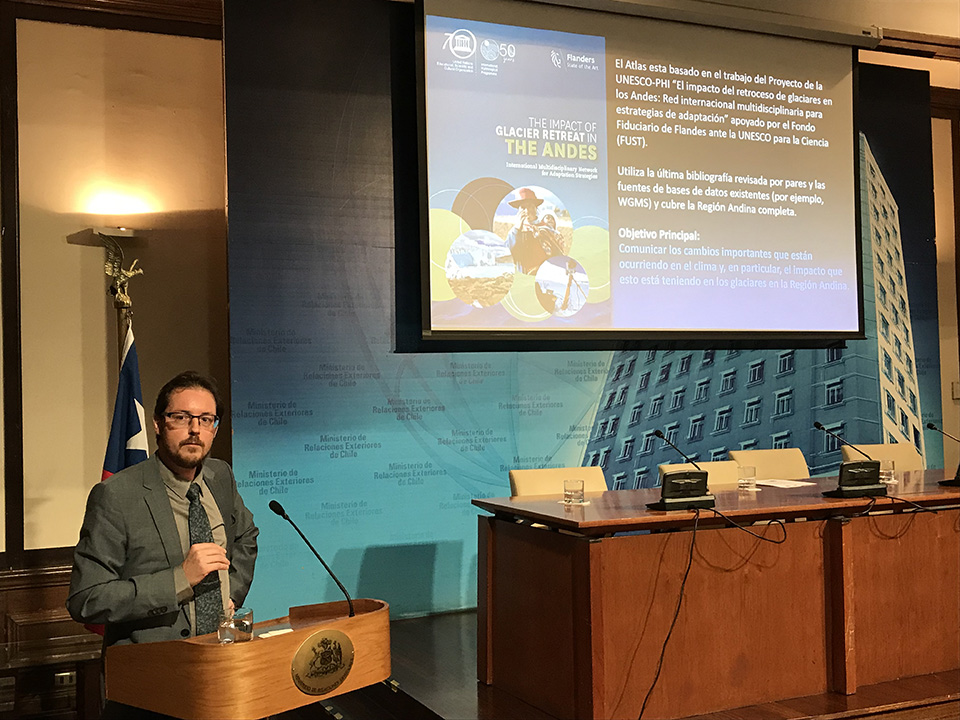 A new publication maps the retreat of Andean glaciers and the associated loss of the glacier meltwater relied upon by millions – and proposes several measures to address this imminent challenge. MRI SLC member Mathias Vuille was among those in Chile earlier this month to celebrate the launch of the Spanish version of this important resource.
A new publication maps the retreat of Andean glaciers and the associated loss of the glacier meltwater relied upon by millions – and proposes several measures to address this imminent challenge. MRI SLC member Mathias Vuille was among those in Chile earlier this month to celebrate the launch of the Spanish version of this important resource. From 24-25 January 2019, nearly 100 scientists, students, practitioners, representatives from NGO’s, and policy- and decision-makers from Andean countries, Europe, and the United States met at the Chilean Ministry of Foreign Affairs in Santiago, Chile to celebrate the launch of the Spanish version of the Andean Glacier and Water Atlas.
During a two-day event, a number of key issues related to the atlas were presented and discussed, kicking off with the Andean Snow and Ice Working Group providing updates from its respective member countries. A subsequent afternoon session was devoted to brainstorming the future role and involvement of UNESCO’s International Hydrological Program in Andean climate change adaptation. Discussion in smaller breakout groups centered around identifying gaps and future needs related to climate change adaptation in the Andes in coming years.
 On the second day, the Andean Glacier and Water Atlas was presented to the plenary, followed by several panels that discussed the impacts of glacier retreat on water resources, ecosystems, and livelihoods – including commonalities and differences between the different Andean countries – as well as policy instruments to address these problems
On the second day, the Andean Glacier and Water Atlas was presented to the plenary, followed by several panels that discussed the impacts of glacier retreat on water resources, ecosystems, and livelihoods – including commonalities and differences between the different Andean countries – as well as policy instruments to address these problemsAn Atlas to Tackle Emerging Challenges
A significant reduction in glacier mass is occurring throughout the Andes. And as glaciers retreat, water security becomes an increasingly pressing issue for the millions of people who rely on glacier meltwater. To tackle this situation, mitigation and adaptation policies based on the scientific understanding of climate impacts on water security are needed. The Andean Glacier and Water Atlas has therefore been compiled by UNESCO GRID-Arendal as part of a multidisciplinary project initiated by UNESCO and aided by the Flanders Fund in Trust. The project, The Impact of Glacier Retreat in the Andes: International Multidisciplinary Network for Adaptation Strategies, aims to improve understanding of vulnerabilities, opportunities, and potential for adaptation to change, particularly climate change.
 The Andean Glacier and Water Atlas illustrates the significant reduction in glacier mass happening throughout the region. It quantifies the contribution of glaciers to drinking water supplies in cities, agriculture, hydropower, and industries such as mining. The findings highlight the impact of shrinking glaciers on water availability and security for millions of people.
The Andean Glacier and Water Atlas illustrates the significant reduction in glacier mass happening throughout the region. It quantifies the contribution of glaciers to drinking water supplies in cities, agriculture, hydropower, and industries such as mining. The findings highlight the impact of shrinking glaciers on water availability and security for millions of people.In order to meet these emerging challenges, the Atlas makes a series of recommendations for policymakers in the region. These include: improving the understanding of climate change impacts on communities in order to strengthen local capacity to develop adaptation responses; better integration of scientific data into political decision-making; improved climate change monitoring infrastructure; integrated water resources management; and strengthened coordination between Andean countries. The Atlas also directly supports the implementation of the Sustainable Development Goals, the Paris Agreement, and the Sendai Framework for Disaster Risk Reduction
Download the Andean Glacier and Water Atlas here.






